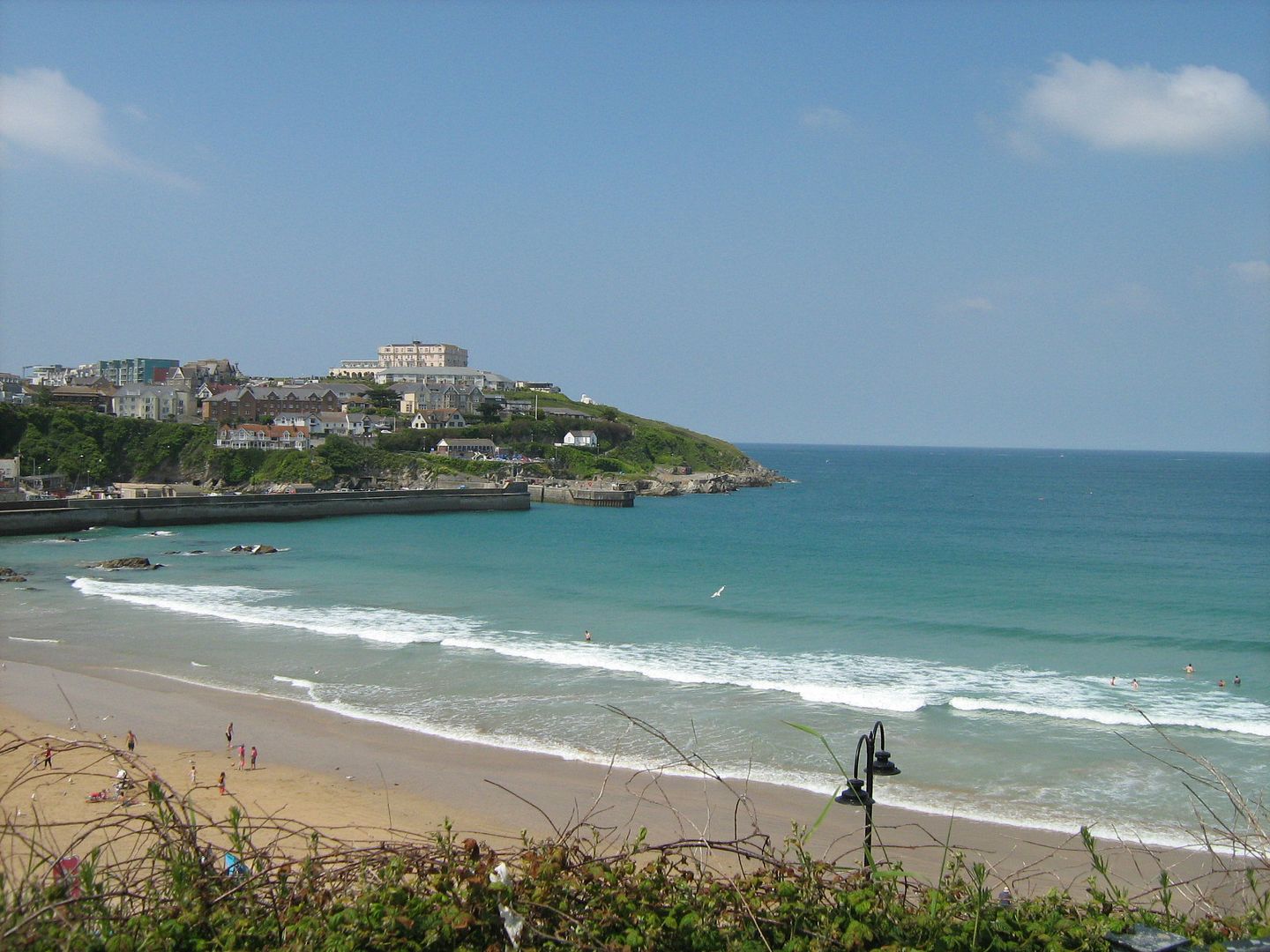the Lemon Market was charming (mostly closed, but what we saw looked nice). We found a friendly (and very clean) native.
We strolled through the Pannier Market (this one was pretty permanent looking- more like Reading Terminal Market in Philadelphia than the flea-market sort of thing they did in Tavistock). We also noted a restaurant and said 'hey, we should remember that' - about which more anon.
We finished up back at the Royal Cornwall Museum a couple of minutes before
it opened. Like the other county
museums we've seen on this trip, this one was remarkably good. They started with a very impressive
collection of stone age tools, then bronze age, then iron age, and Roman. Cornwall doesn't have very much in the way of
Roman artifacts compared to more northern places. The only known villa lacks many of the luxuries
(like the hypocaust and baths) found in other places. The placards informed us that there probably
wasn't a large Roman population here, but rather that the Romans governed
through local chieftans. We strongly
suspected that being sent to Cornwall was possibly not the most prestigious duty
ever.
The museum progressed through more modern eras- Cornwall has a rocky
history of disputes with London (which apparently continue today- we saw
inflammatory posters urging political action on posters in present day
Truro). But we were diverted into a
quite extensive section on geology and mining in Cornwall, which was quite
fascinating. From there we took in other
exhibits- one a gallery of paintings from artists who worked in- and painted-
St. Ives. They earned our admiration by
being all representational (we like that) and some of them were quite
striking.
From there, we went to the Egyptian exhibit. Yes, you read correctly, Egyption. This was quite effective and well done- the
star of the show was their mummy, Iset
Tayef Nakht who was a priest and craftsman in 25th Dynasty mummy at the Temple
of Al Karnack. They had a very striking
reconstruction of what the man would have looked like- done from X-rays of the
skull and forensic reconstruction of the features. The exhibit drew some interesting
parallels between the lifestyles of the contemporary Greeks and Romans, and how
the Egyptians lived. They also had a
kid's mummify your own body exhibit, with instructions on how to remove organs,
put them in the appropriate jars, and then lay wrappings and charms on the
(simulated) body...really, just the sort of thing to appeal to children of a
certain age. Kind of like a cross
between Operation and the Alien Dissection Kit (without the slime).
After going through the exhibit, I was left with only one question, which
was, how the devil did this Egyptian gentleman wind up in Cornwall?! So I asked one of the museum volunteers. It seems that he was excavated and sent to a
local person and they had done a 'mummy unwrapping' (apparently considered good
entertainment in the days before pannier markets). And so they had him, and all his possessions,
and a good deal of information about him.
A descendant had donated the mummy to the museum. His coffin was in excellent condition and
quite beautifully inscribed. The museum
attendant pointed out some of the features of the drawing and told us that they
thought he had worked on his own coffin, being a craftsman, and literate. They also encouraged people to say the
appropriate prayers for him, (translated into English, of course). If there is an afterlife, no doubt Iset Tayef Nakht is one of the best
remembered souls in it.
By this time we were quite hungry, and wasted no time in proceeding down to
the pasty shop down the street that had tantalized us with baking smells when
we had passed by earlier.
From there, we took a bus to Newquay, on the coast and added another to our
growing collection of English seaside towns.
This was one of the more resort-like of towns. We noted no less than three Mexican
restaurants (apparently Mexican is considered vacation food), and innumerable
surf shops. By now the sky was
cloudless and the sun shining down warmly.
We followed the coast path and walked over rocky slate headlands covered
in wildflowers and overlooked long sandy
inlets of beach.
There were a few signs of the harsher past.
We found the 14th century Huer's Hut, where a lookout would be posted to
sound a horn when schools of pilchards would be sighted. Boats would go out with nets held between
them and try to scoop the whole school and drag it to the beach, where salting
and packing of the fish would go on for days.
 |
| Huer's hut |
We also found the lifeboat station, with a steep slide for launching the
boats at the mouth of the harbor. The plaque told us that before the lifeboat
station had been built, lifeboats had needed to be launched from the beach,
which would have taken them far longer to reach the boats in need of
rescue. After the station had been
built, 142 lives had been saved.
 |
| Lifeboat station |
 |
| Lifeboat launching ramp |
Several beaches had quite impressive surf and the surfers were out in
force. Around the headlands, the sea
swirled around the rocks in an ecstasy of creamy foam. I couldn't see any birds, but they were
there in numbers- so many that the birdsong seemed never to stop but just went
on and on. The short explosive tweets
and longer calls made me imagine a bird video game...Jonathan says I'm weird.
When we reached the river Gannel, we found that the tide was high. There was a low-water footbridge nearer the
mouth and a low-water crossing marked further up, but at high water, the best
way across was by ferry. We stopped for
some ice cream, then descended a long narrow cliff stair to reach the
waterside, and a cheerful gentleman with a motorboat ran us across the river
for a nominal sum.
 |
| River Gannel |
On alighting in Truro, we considered our dinner options. There were several restaurants recommended by
our guidebook, but they nearly all were geared to expensive dressy places with
beautifully arranged exotic food that isn't really us. (Not to mention the part where the sunburned,
windblown, T-shirts and jeans look would have kind of stood out.) We looked around for more down-home kinds of
places, and finally decided to go to the Italian restaurant we'd spotted that morning. Which we then couldn't find. By the time we'd circled the center of Truro twice, we were quite hungry and not a little annoyed. We both remembered it...but neither one of us exactly could recall where. We checked out a bunch of other options we spotted along the way, but didn't see anything that appealed. Finally, we tried retracing our steps from the beginning of the day and located the restaurant...we'd evidently walked right by it without seeing it!






No comments:
Post a Comment